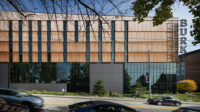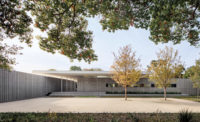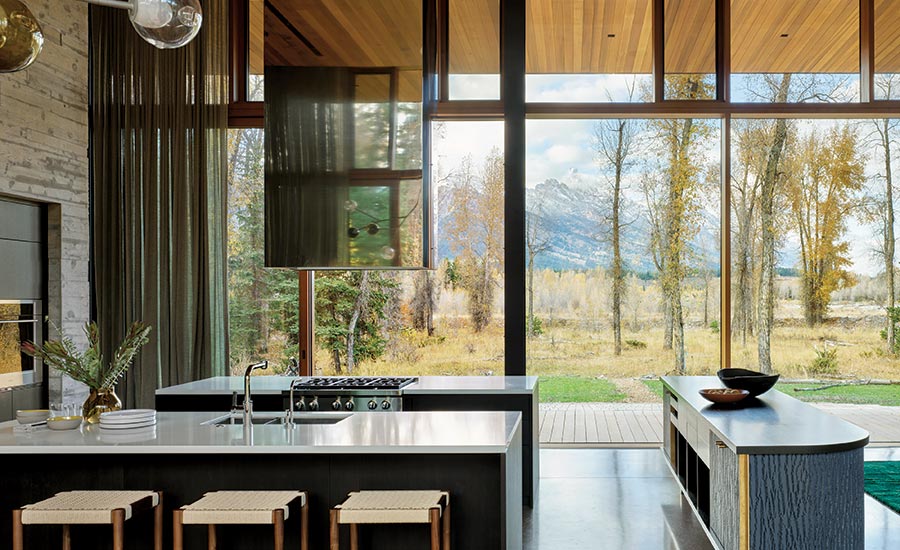Riverbend Residence by Carney Logan Burke Architects
Jackson, Wyoming

The county limits glass usage, so the team strategized carefully, placing extensive glazing in the living area for views through the house, across cedar-lined decks and, from the north, out to the Teton Range.
Photo © Matthew Millman

The house is wrapped in hot-rolled steel plate with a wax coating that will weather slowly in the dry climate; the skin is most apparent on the short, opaque west elevation.
Photo © Matthew Millman

A 1,000-square-foot guesthouse is connected to the main residence by a large wood platform among Aspen trees.
Photo © Matthew Millman

Broad decks surrounding the house form outside rooms for cooking, eating, and relaxing.
Photo © Matthew Millman

The Tetons are visible through floor-to-ceiling glazing in the living area and kitchen. The range hood is made of stainless steel. “Hoods become an exercise,” says CLB associate Jennifer Mei. “They’re critical, but no one wants to look at them.”
Photo © Matthew Millman

The living area has a view of the Tetons.
Photo © Matthew Millman

The dining area looks south.
Photo © Matthew Millman

All the private spaces, including the master bedroom and a bunk room, link to the exterior. From the master suite, cedar plank flows to the deck, blurring the line between inside and out.
Photo © Matthew Millman

Floors and millwork in the kids’ wing are of beechwood.
Photo © Matthew Millman

Image courtesy Carney Logan Burke Architects

Image courtesy Carney Logan Burke Architects











Architects & Firms
Sprawling between the Teton and Gros Ventre mountain ranges in Wyoming, the valley of Jackson Hole is “America the Beautiful” made manifest, with its majestic peaks, winding rivers, and big skies. Home to an abundance of wildlife, from bison to bald eagles, the area is also a major destination for outdoor enthusiasts and thrill seekers, especially with its proximity to Yellowstone and Grand Teton national parks.
Additional Content:
Jump to credits & specifications
So there’s some irony to the architectural vocabulary that has taken hold here as tourism has flourished and, increasingly, moneyed second home owners have flowed in. Epitomized by log-cabin-style homes, with their outsize stone fireplaces and antler chandeliers, the typology, while hoping to capture the western pioneering spirit, is one that tends to look inward. Bucking this trend, the Riverbend Residence, by local architects Carney Logan Burke (CLB), takes full advantage of its awe-inspiring surroundings, with strong connections to the world beyond its walls.
Built as a retreat for a Berkeley couple, their two teenage children, and their extended family and friends, the 6,250-square-foot house could hardly be simpler in concept. A concrete-and-steel, bar-shaped structure with a steel plate skin, it is surrounded by broad decks with 10-foot overhangs that form outdoor, cedar-lined rooms. The long, slender form, running east to west, addresses a common dilemma in the valley, notes principal Kevin Burke. “All the lots are south of the Tetons, so we are constantly hung up with this quandary of getting the views to the north yet also emphasizing the south exposure to stay warm in this crazy environment.” Abundant glazing and the decks link interiors to the outdoors: a minimally landscaped and planked terrace, demarcated by the perpendicularly sited guesthouse and woods to the south, and, to the north, the Snake River and the panorama of the Teton Range gloriously splayed across the horizon.
The husband, who grew up in Berkeley, spent much of his childhood hiking and climbing in Jackson Hole. Still in love with the area, he and his wife purchased a house there about 10 years ago—a 1970s log cabin with low ceilings and small punched windows—within a bucolic subdivision north of Jackson named Solitude. Though she was enamored of the valley, the wife, who was raised in California’s Mojave Desert, had an adverse reaction to the house. “My soul needs light, sky, expansive views,” she says. “I had a physical response to this house in the woods, bogged down by timber. I would shut down.” So, when a nearby 17-acre lot came on the market, she jumped at the opportunity, convincing her husband to try something new with this exceptional site, which sits in a cottonwood-dotted riparian landscape at a bend in the Snake River, the only major feature lying between it and Grand Teton National Park. With a desire to work locally as much as possible, the couple turned to CLB.
The two gave the design team a lot of creative license. “Their list of requirements was pretty short,” says principal Eric Logan, “beyond the programmatic demands and an emphasis on treading lightly on the land” (a prerequisite given that much of the couple’s philanthropic work focuses on environmental causes). “She wanted something modern that reflected her values. He just wanted some warmth.” And, of course, there was the underlying assumption that they were here to experience the wilderness. When the team initially visited the site with the clients, they mounted the viewing platform they had erected and took in the vista over the levee that runs along the river. It was suddenly obvious what they needed to do, say the architects. “Really, the house just had to replicate that experience,” says Logan. “Essentially, we needed to do a remodel of the platform.”
To achieve the same vantage point, the team raised the main part of the house 5 feet (excavation spoils were used to elevate the south yard, and topsoil, which had been scraped, was later repurposed). You enter at grade and ascend a short run of stairs into the living area to the west, with its 16-foot ceilings, and the master suite beyond. Another short run of stairs scissors up to the more compressed family room and the kids’ bedrooms to the east, which are stacked atop a guest suite and the garage, contained within a board-formed concrete envelope, below. It’s like a split-level on steroids.
Steel columns in the double-height living area are left exposed along the glass perimeter. All glazing is triple-paned and, in combination with a super-insulated envelope, geothermal system, and radiant flooring, make for efficient operation. Bookending the living area are two board-formed concrete walls that, at one end, delineate the boundary of the kitchen and, at the other, hold a large fireplace. Because the house sits on the Teton Fault, these elements also function as shear walls, resisting seismic forces. The team crafted the formwork of charred wood boards, which left a sympathetic earth toned hue across the concrete expanses. The board-formed walls extend outside, as do other elements: the cedar ceiling transitions into the exterior cladding; the concrete floors, with a subtle rose-colored tint and inflections of green glass, flows outside in places in an unpolished state. Though, on paper, the building blocks—concrete, steel, glass—are tough, the sensitive application here, in combination with the wood, has resulted in gracious, inviting interiors, quelling the husband’s initial concern that a modern design would project a hotel-like iciness. On a recent afternoon, record-breaking snow (which necessitated cross-country skis for circumnavigating the exterior of the house) continued to fall, shrouding the landscape in white, the ground plane morphing into the sky. As the sun set, the backdrop shifted to a brilliant periwinkle. Inside the living room, looking out through floor-to-ceiling windows to the north and south, a sense of freedom pervaded—that feeling the wife had been looking for—along with the warm embrace you want in a home.
In a valley rife with the trappings of National Park–inspired design, the architects are happy to bring clients along as they depart from these memes, imbuing their work with their own interpretations of what the West has to offer. “There’s a lot of wonderful stuff we see, driving around the landscape of Wyoming, like rusty pickups, ag ranch buildings, snow fences,” says Logan. “They are unpretentious, matter-of-fact moments that somehow feel appropriate to me.” With the Riverbend Residence, the team has effectively captured this spirit with a straightforward formal solution and restrained use of materials. “It’s just a dumb box, after all,” says Logan, “rendered in a palette intended to weather and blend with the environs over time.”
CreditsArchitect: Carney Logan Burke Architects — Eric Logan, Kevin Burke, Jennifer Mei, Bryan James, Leo Naegele, Libby Erker
Landscape architect: Hershberger Design
Engineering: KL&A (structural); JM Engineers (mechanical); Nelson Engineering (civil); Jorgensen Geotechnical; Helius Lighting Group
General contractor: Peak Builders |
SpecificationsCurtain wall Grabill
Skylights Aladin Skylights
Custom millwork Poliform, Western Woodworks, Brandner Design, Willow Creek Woodworks
Paints & stains Sherwin-Williams
Solid surfacing Caesarstone, SculptureStone, Corian
Plumbing Franke, Dornbracht, Rohl, Vola, Victoria + Albert, Waterworks
Furnishings Kartell, Knoll, Herman Miller, Gandia Blasco, Foscarini, Moooi, Poltrona Frau, Blu Dot, Cassina |















